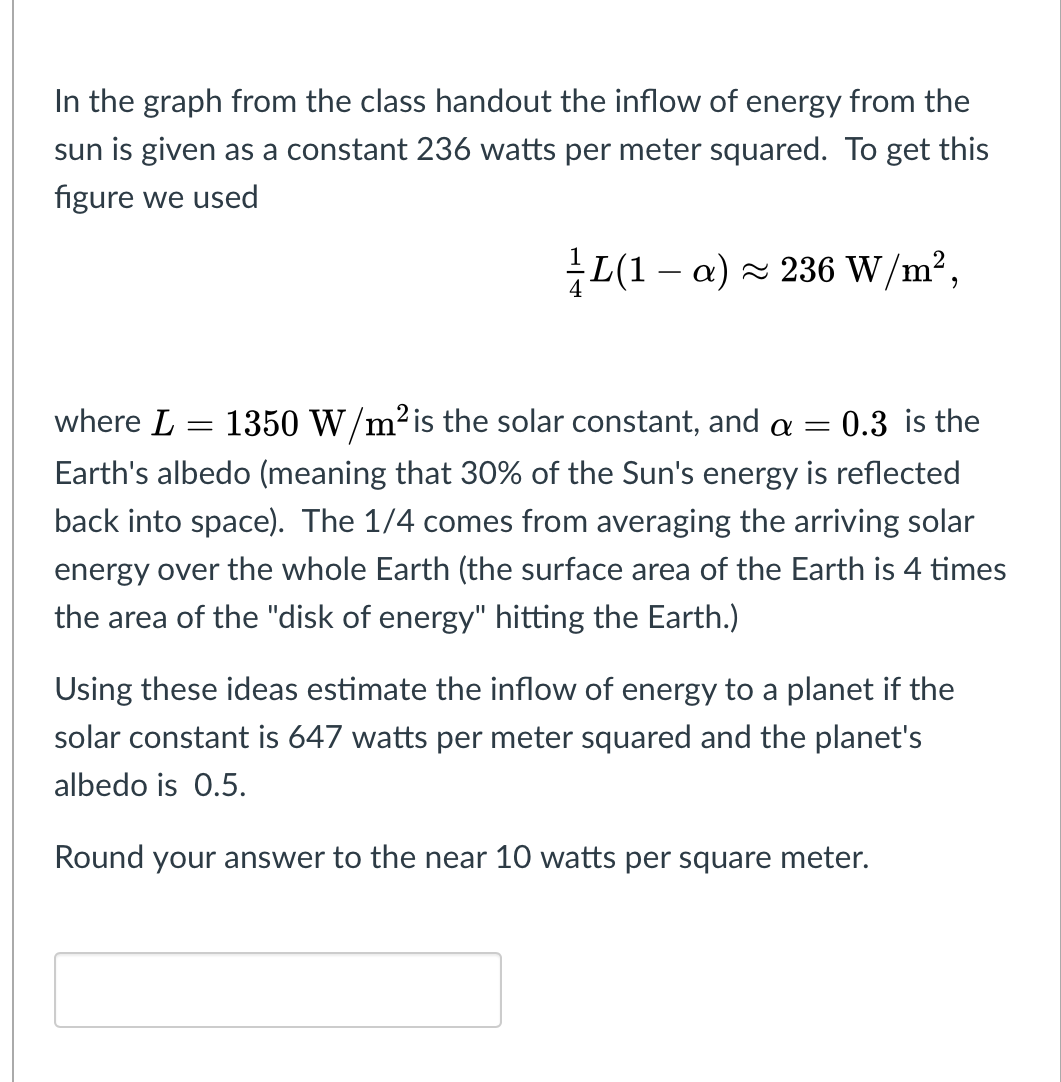In the graph from the class handout the inflow of energy from the sun is given as a constant 236 watts per meter squared. To get this figure we used L(1 – a) × 236 W/m², where L = 1350 W/m²is the solar constant, and a = 0.3 is the Earth's albedo (meaning that 30% of the Sun's energy is reflected back into space). The 1/4 comes from averaging the arriving solar energy over the whole Earth (the surface area of the Earth is 4 times the area of the "disk of energy" hitting the Earth.) Using these ideas estimate the inflow of energy to a planet if the solar constant is 647 watts per meter squared and the planet's albedo is 0.5. Round your answer to the near 10 watts per square meter.
In the graph from the class handout the inflow of energy from the sun is given as a constant 236 watts per meter squared. To get this figure we used L(1 – a) × 236 W/m², where L = 1350 W/m²is the solar constant, and a = 0.3 is the Earth's albedo (meaning that 30% of the Sun's energy is reflected back into space). The 1/4 comes from averaging the arriving solar energy over the whole Earth (the surface area of the Earth is 4 times the area of the "disk of energy" hitting the Earth.) Using these ideas estimate the inflow of energy to a planet if the solar constant is 647 watts per meter squared and the planet's albedo is 0.5. Round your answer to the near 10 watts per square meter.
Chapter1: Temperature And Heat
Section: Chapter Questions
Problem 46P: An Associated Press article on climate change said, "Some of the ice shelf 's disappearance was...
Related questions
Question

Transcribed Image Text:In the graph from the class handout the inflow of energy from the
sun is given as a constant 236 watts per meter squared. To get this
figure we used
L(1 – a) × 236 W/m²,
where L = 1350 W/m²is the solar constant, and a = 0.3 is the
Earth's albedo (meaning that 30% of the Sun's energy is reflected
back into space). The 1/4 comes from averaging the arriving solar
energy over the whole Earth (the surface area of the Earth is 4 times
the area of the "disk of energy" hitting the Earth.)
Using these ideas estimate the inflow of energy to a planet if the
solar constant is 647 watts per meter squared and the planet's
albedo is 0.5.
Round your answer to the near 10 watts per square meter.
Expert Solution
This question has been solved!
Explore an expertly crafted, step-by-step solution for a thorough understanding of key concepts.
This is a popular solution!
Trending now
This is a popular solution!
Step by step
Solved in 2 steps

Knowledge Booster
Learn more about
Need a deep-dive on the concept behind this application? Look no further. Learn more about this topic, physics and related others by exploring similar questions and additional content below.Recommended textbooks for you


Foundations of Astronomy (MindTap Course List)
Physics
ISBN:
9781337399920
Author:
Michael A. Seeds, Dana Backman
Publisher:
Cengage Learning

An Introduction to Physical Science
Physics
ISBN:
9781305079137
Author:
James Shipman, Jerry D. Wilson, Charles A. Higgins, Omar Torres
Publisher:
Cengage Learning


Foundations of Astronomy (MindTap Course List)
Physics
ISBN:
9781337399920
Author:
Michael A. Seeds, Dana Backman
Publisher:
Cengage Learning

An Introduction to Physical Science
Physics
ISBN:
9781305079137
Author:
James Shipman, Jerry D. Wilson, Charles A. Higgins, Omar Torres
Publisher:
Cengage Learning

Stars and Galaxies
Physics
ISBN:
9781305120785
Author:
Michael A. Seeds, Dana Backman
Publisher:
Cengage Learning

Astronomy
Physics
ISBN:
9781938168284
Author:
Andrew Fraknoi; David Morrison; Sidney C. Wolff
Publisher:
OpenStax

Horizons: Exploring the Universe (MindTap Course …
Physics
ISBN:
9781305960961
Author:
Michael A. Seeds, Dana Backman
Publisher:
Cengage Learning